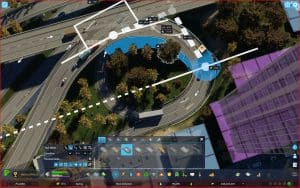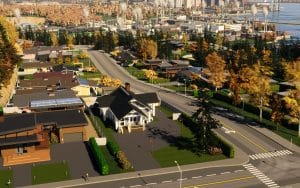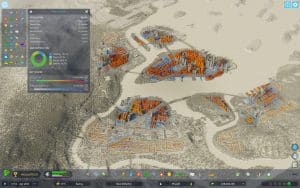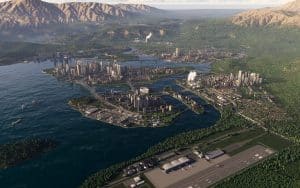Cities: Skylines II
Related Games
Description
🔥 What is Cities: Skylines II for PC
Cities: Skylines II is a city-building simulation developed by Colossal Order and published by Paradox Interactive, serving as the ambitious sequel to the highly successful original Cities: Skylines. Released for PC and consoles, the game builds upon the deep systems of its predecessor while striving for more realism, complexity, and freedom in city planning. Players once again step into the role of a modern mayor, tasked with balancing the competing demands of citizens, infrastructure, economy, and the environment.
Unlike traditional city-builders that focus on pre-designed scenarios, Cities: Skylines II gives you a blank canvas where every decision, from road layout to taxation, shapes the long-term growth of your city. The game emphasizes simulation depth, with detailed mechanics for traffic, climate, citizen behavior, and economic cycles. Each choice you make ripples outward, creating both opportunities and challenges that test your foresight and adaptability.
At its core, the game is not just about building skyscrapers or laying down highways, but about managing a living ecosystem where people, industries, and policies interconnect. By offering new systems for seasons, electricity grids, and more granular citizen lifecycles, Cities: Skylines II pushes the city-builder genre closer to a true urban simulator. For veterans and newcomers alike, it provides a sandbox of possibilities combined with the weight of mayoral responsibility.
👉 Features of Cities: Skylines II
Vast Map Sizes and Increased Scale
The sequel allows players to build larger and more interconnected cities than ever before, thanks to significantly expanded map sizes. Unlike the first game, where cities were often confined to smaller grids, Cities: Skylines II encourages sprawling metropolises that can rival real-world urban expanses.
Dynamic Weather and Seasons
One of the most important additions is the inclusion of seasonal changes and dynamic weather that affect gameplay. Winters bring increased energy consumption, while heavy rainfall can stress drainage systems. These natural shifts add unpredictability and force mayors to plan resilient infrastructure.
Detailed Citizen Simulation
Citizens now live more realistic lives, following detailed routines such as commuting, working, and retiring. Each person’s needs, lifespan, and choices contribute to the larger flow of society, making the city feel alive rather than just a static grid of buildings.
Advanced Infrastructure and Utilities
From complex highway interchanges to carefully balanced power grids, Cities: Skylines II gives players deeper control over utilities and infrastructure. Energy sources have varying reliability, pollution levels, and costs, while road-building tools allow for more fluid customization.
Economic and Policy Depth
Taxes, trade, loans, and social policies all play a greater role in shaping the prosperity of your city. Players can fine-tune economic strategies or pass policies that influence everything from housing density to environmental sustainability, offering multiple pathways to success.
Gameplay
Building and Planning at a Massive Scale
Cities: Skylines II puts players at the heart of urban planning, where every highway, power line, and residential zone plays into a larger ecosystem. Unlike its predecessor, the sequel encourages a more holistic approach by intertwining land use, climate, and economy in ways that constantly challenge your strategy.
Building doesn’t just mean placing roads and houses; it requires thinking about long-term consequences. Expanding suburbs might boost population, but without adequate public transport or hospitals, traffic jams and unhappy citizens will quickly arise. The game demands foresight rather than just expansion for expansion’s sake.
Transportation Systems and Traffic Management
Traffic is no longer a mere nuisance but a core challenge that defines the city’s efficiency. Players must carefully design public transport networks, optimize intersections, and account for how weather impacts driving patterns. Every traffic jam is a puzzle revealing flaws in your planning, and every smooth commute feels like a triumph of design.
Public transportation has been expanded, with trams, subways, buses, and even intercity train connections offering both mobility and atmosphere. Deciding how these systems interlock can make or break the economic health of your city.
Citizen Lifecycles and Society
Unlike the first game, where citizens felt more like data points, Cities: Skylines II introduces detailed lifecycles. Citizens are born, grow up, find jobs, and eventually retire, giving a sense of generational change. Policies such as education, healthcare, and housing influence these lives directly, making every decision impactful on both a micro and macro scale.
This layer of simulation transforms the game from a purely structural sandbox into something closer to a living organism, where your decisions about schooling or pollution affect individuals as much as entire neighborhoods.
Economy and Challenges
The economy is dynamic and shaped by global influences as well as local choices. A sudden increase in energy costs or a downturn in industry can shake your plans, forcing you to adapt strategies quickly. Players can impose taxes, take loans, or regulate industries to survive economic downturns, adding a layer of strategy beyond construction.
Failure to prepare for these fluctuations can leave your city bankrupt or socially unstable, while successful adaptation can set the stage for prosperity and cultural growth.
Graphics
Realistic Visual Design
Cities: Skylines II takes a more grounded and realistic approach to visuals, presenting lifelike architecture, natural landscapes, and weather systems. Each building, from small suburban homes to massive skyscrapers, has been modeled with impressive attention to scale and style.
Atmospheric Lighting and Weather Effects
The new lighting system enhances immersion, with sunsets casting long shadows across skyscrapers and storms rolling in with dramatic clouds. Seasonal transitions alter not only the visuals but also the emotional tone of the city, making players feel more connected to its rhythm.
Smooth Animations and Lively Streets
Citizens move fluidly through the city, with pedestrians, vehicles, and trains blending into believable patterns. Watching a morning rush hour unfold or a festival take over downtown gives the city vibrancy, making it feel like a living, breathing world.
Performance and Technical Aspects
While visually stunning, Cities: Skylines II has faced criticism for optimization issues on launch, particularly on mid-range PCs. However, patches continue to improve performance, and the graphical fidelity remains a highlight when the game runs smoothly. The inclusion of detailed settings allows players to adjust quality for balance between visuals and performance.
Pros and Cons
✔️ Pros
- Deep and realistic simulation systems that interconnect across citizens, economy, and infrastructure
- Vast maps that encourage sprawling city-building and creative planning
- Dynamic weather and seasonal changes that impact gameplay meaningfully
- Enhanced citizen lifecycles that make the city feel alive and evolving
❌ Cons
- Performance issues and optimization problems at launch can hinder enjoyment
- Steeper learning curve may overwhelm newcomers with complexity
- Requires significant time investment before a city feels stable and satisfying
ℹ️ Game information
Release Date: 23/10/2023
Update Date: 22/11/2025
Version: v1.4.2f1
Genre: Simulation / Strategy
Platform: PC
Language: ![]()
![]()
![]()
![]()
![]()
![]()
![]()
![]()
Weight: 60 GB
Additional info: New version includes all DLCs to date
⭐ Installation Instructions
- The game is fully complete, you just need to install it, so there is no need to unpack it or download it from other sources.
- Just run the Cities: Skylines II.exe installation file.
- Simply launch the game from shortcut desktop.
⚙️ System Requirements
✅ Minimum:
- OS: Windows 10 64bit
- Processor: Intel Core i7-6700K | AMD Ryzen 5 2600X
- Memory: 8 GB RAM
- Graphics: Nvidia GeForce GTX 970 (4 GB) | AMD Radeon RX 480 (8 GB)
- DirectX: Version 11
- Network: Broadband Internet connection
- Storage: 60 GB available space
✅ Recommended:
- OS: Windows 10 64bit
- Processor: Intel Core i5-12600K | AMD Ryzen 7 5800X
- Memory: 16 GB RAM
- Graphics: Nvidia GeForce RTX 3080 (10 GB) | AMD Radeon RX 6800 XT (16 GB)
- DirectX: Version 11
- Network: Broadband Internet connection
- Storage: 60 GB available space
Images




Video
Developer's games
What's new





